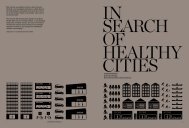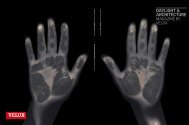Download as PDF - Daylight & Architecture - Magazine by | VELUX
Download as PDF - Daylight & Architecture - Magazine by | VELUX
Download as PDF - Daylight & Architecture - Magazine by | VELUX
Create successful ePaper yourself
Turn your PDF publications into a flip-book with our unique Google optimized e-Paper software.
Even the colour of the sky h<strong>as</strong>lefts its traces in our genes:the photoreceptors of our‘biological clock’ react moresensitively to blue light thanto any other colour.advance (go to bed earlier) or delay (go tobed later) the circadian system dependingon the timing of exposure. Under conditionsof solar light exposure, light arounddusk causes a delay of the clock, where<strong>as</strong>light exposure around dawn will advancethe clock. This delaying and advancingeffect of light keeps the SCN locked ontoto the solar day. Such differential effectsof light become vitally important whentrying to understand the impact of jet lag,shift work (see below), or building designon sleep/wake timing.The pRGCs are not <strong>as</strong> sensitive to light<strong>as</strong> the rods and cones, so that short lightexposure that is e<strong>as</strong>ily detected <strong>by</strong> thevisual system is not recognised <strong>by</strong> thepRGCs. However, dim light can have aneffect if it is delivered over long periodsof time. Thus relatively dim indoor roomlight from bedside lamps and computerscreens (less than 100 lux) can have me<strong>as</strong>ureableeffects on the clock and arousalsystems over several hours, and may exacerbatesleep disorders. Collectively, theseeffects of light – spectral composition,time of exposure and brightness – havewidespread clinical and occupational applicationsin not only treating sleep disordersand fatigue but in the architecture ofhospitals, schools, offices, retail space anddomestic buildings.Disrupting the clock –shift work and 24/7The introduction of electricity and artificiallight in the 19th century and the restructuringof work times have progressivelydetached us from the solar 24-hourcycles of light and dark. The consequenceh<strong>as</strong> been disruption of the circadian andsleep systems. Much h<strong>as</strong> been writtenabout the effects of this disruption, andin general terms the effects are clear(Table 1). Sleep and circadian rhythmdisruption results in performance deficitsthat include incre<strong>as</strong>ed errors, poorvigilance, poor memory, reduced mentaland physical reaction times and reducedmotivation. Sleep deprivation and disruptionare also <strong>as</strong>sociated with a rangeof metabolic abnormalities, includingthe glucose/insulin axis. For example,sleep disrupted individuals take longerto regulate blood-glucose levels and insulincan fall to levels seen in the earlystages of diabetes — abnormalities thatcan be reversed <strong>by</strong> normal sleep. Such resultshave suggested that long-term sleepand circadian rhythm disruption mightcontribute to chronic conditions such <strong>as</strong>diabetes, obesity and hypertension. Furthermore,obesity is strongly correlatedwith sleep apnoea and hence additionalsleep disturbance. Under these circumstancesa dangerous positive feedbackloop of obesity and sleep disturbance canoften result.Sleep loss and circadian rhythm disruptionare most obvious in night-shiftworkers. More than 20% of the populationof employment age work at le<strong>as</strong>tsome of the time outside the 07.00–19.00day.Josephine Arendt at the University ofSurrey makes the point: “Because of theirrapidly changing and conflicting lightdarkexposure and activity-rest behaviour,shift workers can have symptoms similarto those of jet lag. Although travellers normallyadapt to the new time zone, shiftworkersusually live out of ph<strong>as</strong>e with localtime cues”. Even after 20 years of nightshiftwork, individuals will not normallyshift their circadian rhythms in responseto the demands of working at night. Despitethe great variety and complexity of‘shift systems’, none have been able to alleviatefully the circadian problems <strong>as</strong>sociatedwith shift work. Metabolism, alongwith alertness and performance, are stillhigh during the day when the night-shiftworker is trying to sleep and low at nightwhen the individual is trying to work. Amisaligned physiology, along with poorsleep, in night-shift workers h<strong>as</strong> been <strong>as</strong>sociatedwith incre<strong>as</strong>ed cardiov<strong>as</strong>cularmortality, an eight-fold higher incidenceof peptic ulcers, and a higher risk of someforms of cancer. Other problems includea greater risk of accidents, chronic fatigue,excessive sleepiness, difficulty sleepingand higher rates of substance abuse anddepression. Night-shift workers are alsomuch more likely to view their jobs <strong>as</strong>extremely stressful.So why don’t shift-workers shift theirclocks? After all, if we travel across multipletime zones we do recover from jetlag and entrain to local time. The answerseems to be that the pRGCs that entrainthe circadian system are fairly insensitiveto light. The clock always respondsto bright natural sunlight in preferenceto the dim artificial light commonly foundin the workplace. It is not obvious butshortly after dawn, natural light is some50 times brighter than normal office lighting(300–500 lux), and at noon naturallight can be 500 to 1,000 times brighter– even in Northern Europe. Thus exposureto strong natural light on the journey toand from work, combined with low levelsof light in the workplace, entrains thenight-shift worker onto local time. In thisway biological and social time are persistentlymisaligned in night-shift workers.In the absence of any natural light, however,the clock will eventually respond toman-made light. Theoretically this informationcould be used to develop practicalcounterme<strong>as</strong>ures to the problems ofworking at night. However, most nightshiftworkers prefer not to be adapted toa reversed sleep-wake cycle <strong>as</strong> they liketo spend their work-free time with familyand friends at maximum alertness. Onesuggestion h<strong>as</strong> been to select individualsTable 1Consequences of Circadian RhythmDisruption and Shortened SleepDrowsiness/microsleeps/unintended sleepAbrupt mood shiftsIncre<strong>as</strong>ed irritabilityAnxiety and depressionWeight gainDecre<strong>as</strong>ed socialisation skillsand sense of humourDecre<strong>as</strong>ed motor performanceDecre<strong>as</strong>ed cognitive performanceReduced ability to concentrate and rememberReduced communication and decision skillsIncre<strong>as</strong>ed risk-takingReduced quality, creativity and productivityReduced immunity to dise<strong>as</strong>e and viral infectionFeelings of being chilledReduced ability to handle complext<strong>as</strong>ks or multi-t<strong>as</strong>kIncre<strong>as</strong>ed risk of substance abuse11










